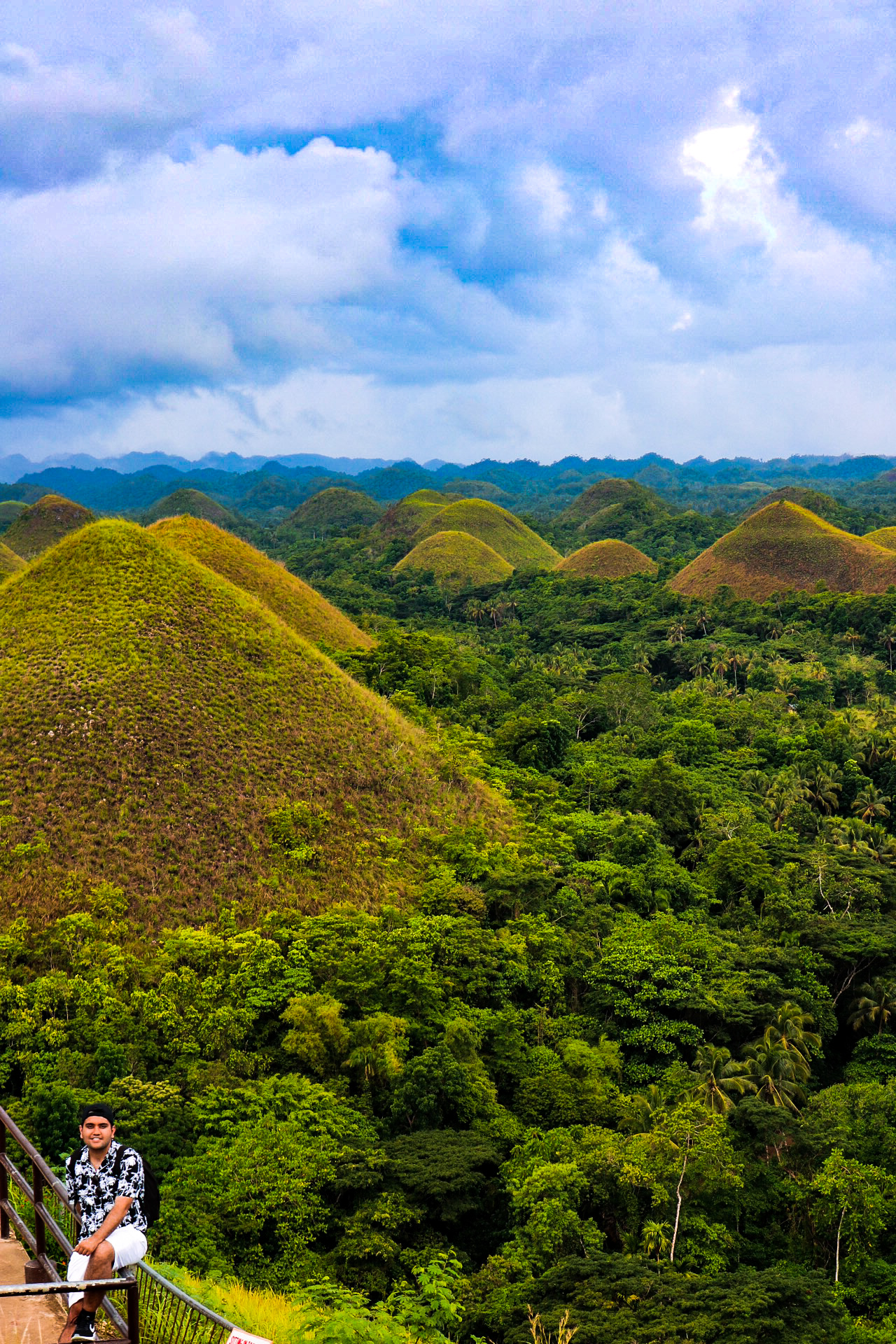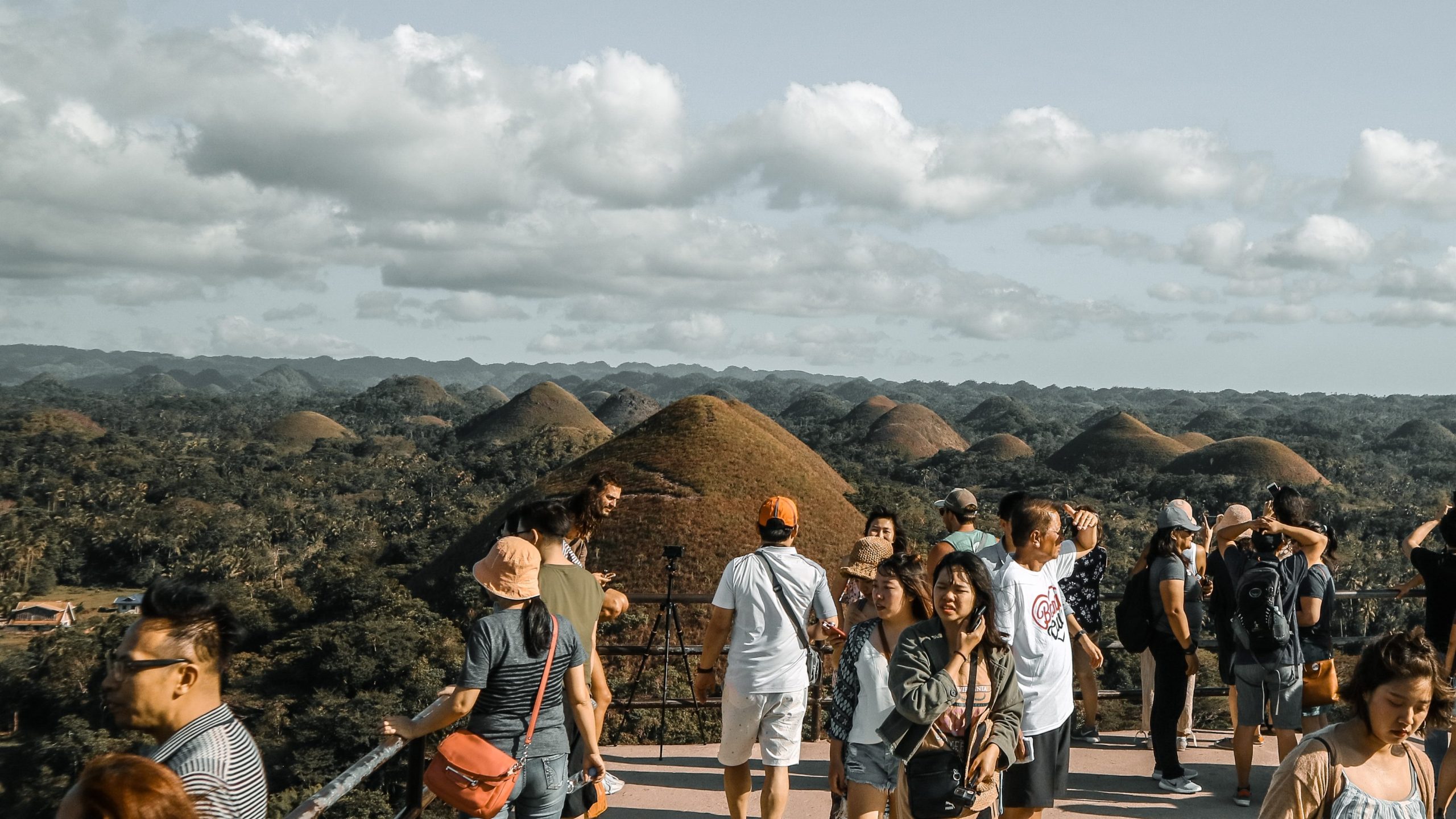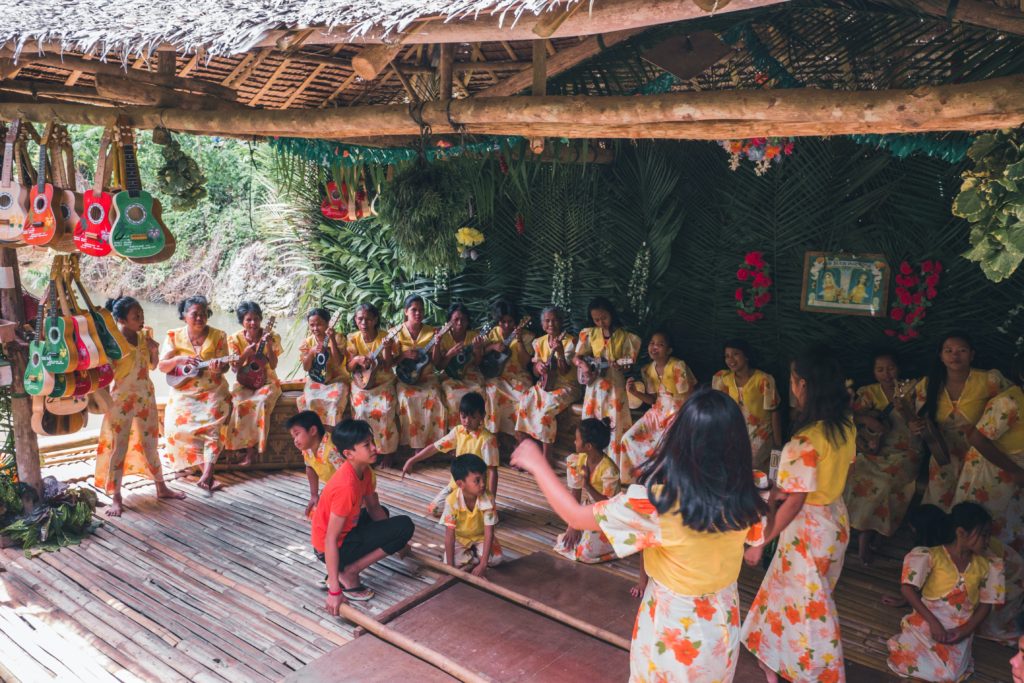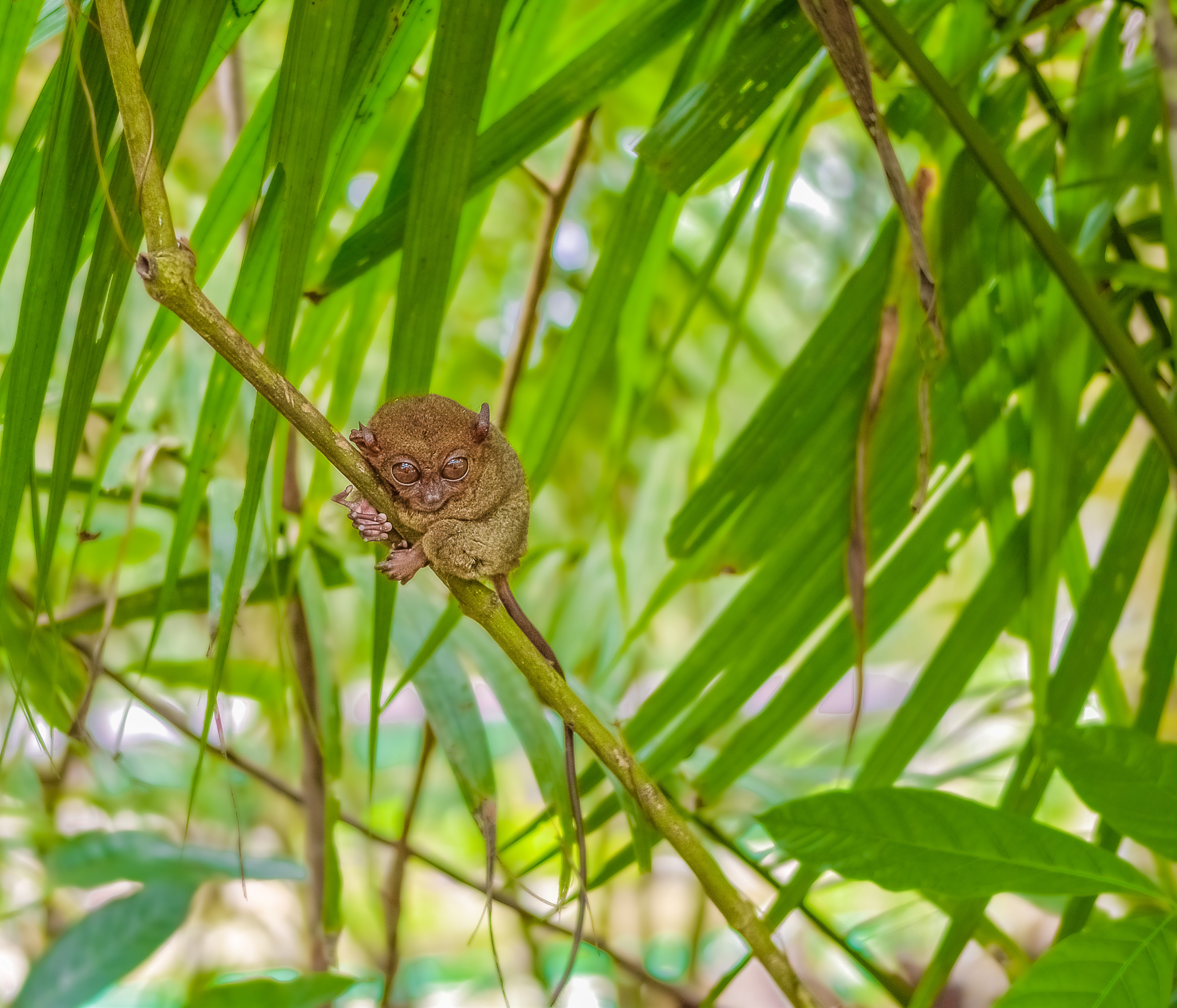Travel Guide: Chocolate Hills, Bohol, Philippines
The Chocolate Hills (or chocolate mountains) are a geological formation located in Bohol, Philippines. They are one of the most famous and unique natural landmarks in the country and one of the tourist attractions that is a must if it is your first trip to the Philippines. The Chocolate Hills consist of around 1,268 perfectly cone-shaped hills that cover an area of over 50 square kilometres (20 square miles) on the island of Bohol. Below is my ‘Travel Guide: Chocolate Hills, Bohol, Philippines’ to help make sure you get the best out of visiting this place.
The name “Chocolate Hills” comes from the fact that during the dry season, the green grass covering the hills turns brown, giving them a resemblance to chocolate mounds. This transformation in colour is what led to the name. During the wet season, the hills become lush and green. There is a viewing deck where you can get incredible pictures of this landscape like the one my friends managed to capture of me!

The origin of the Chocolate Hills is attributed to the uplift of coral deposits and the action of erosion over millions of years. They are primarily made of limestone and are relatively uniform in shape, with heights ranging from around 30 to 50 meters (98 to 164 feet). The hills are spread across a wide area, creating a visually striking landscape that has become a major tourist attraction in the Philippines.
The Chocolate Hills have gained recognition both locally and internationally. They were declared the country’s third National Geological Monument and have been proposed for inclusion in the UNESCO World Heritage List. The hills also play a significant role in local folklore and mythology. According to one popular legend, the hills were formed from the tears of a giant who had lost his love.
Visitors to the Chocolate Hills can appreciate the panoramic view from viewing decks located in some of the hills. These viewpoints offer breathtaking vistas of the rolling hills, making it a favourite spot for photography and sightseeing. The hills are also often visited in combination with other attractions on the island of Bohol, such as the tarsier conservation area and the historic Baclayon Church.
Overall, the Chocolate Hills stand as a natural wonder that showcases the beauty and diversity of the Philippines’ landscape, drawing tourists from around the world to marvel at their unique and picturesque appearance.
Travelling to the Chocolate Hills From Cebu City
To get to the Chocolate Hills from Cebu City, you’ll need to take a combination of transportation modes, as the Chocolate Hills are located on the island of Bohol. Here’s a step-by-step guide on how to get there:
Step 1: Travel from Cebu City to Bohol
- Ferry from Cebu to Tagbilaran, Bohol: Start by travelling from Cebu City to Tagbilaran, the capital city of Bohol. There are several ferry companies that operate routes between Cebu City and Tagbilaran. The most common route is from Cebu’s Pier 1 to Tagbilaran’s Bohol Port. Ferry schedules and availability may vary, so it’s recommended to check the current schedules and book your tickets in advance.
- Flight from Mactan-Cebu International Airport to Tagbilaran Airport: Another option is to take a direct flight from Mactan-Cebu International Airport (located in Lapu-Lapu City, near Cebu City) to Tagbilaran Airport in Bohol. Several airlines operate flights on this route, but flight availability and schedules can vary.
Step 2: Travel within Bohol
Once you arrive in Tagbilaran, you can use various transportation options to reach the Chocolate Hills:
- Public Bus or Van: From Tagbilaran, you can take a public bus or a shared van (known as a “V-hire”) to Carmen, the municipality where the Chocolate Hills are located. The town of Carmen is approximately 55 kilometers (34 miles) away from Tagbilaran. Buses and vans usually depart from the Dao Integrated Bus Terminal in Tagbilaran.
- Private Vehicle or Tour: If you prefer a more convenient option, you can also hire a private vehicle or join a guided tour that includes transportation to the Chocolate Hills. Many tour agencies in Tagbilaran offer day trips to the Chocolate Hills and other attractions in Bohol.
Step 3: Arrival at Chocolate Hills
Once you arrive in Carmen, you will need to pay an entrance fee to access the Chocolate Hills complex and viewing platform. The complex includes a viewing deck that provides panoramic views of the hills. You can hike up to the viewing area to get a closer look at the Chocolate Hills and take in the magnificent view of these hills at any time of the year.
Keep in mind that travel conditions, schedules, and availability can change, so it’s a good idea to do some research and planning before your trip. Check the latest transportation options, schedules, and fees to ensure a smooth journey to the Chocolate Hills from Cebu City.

The Big Question- How Did The Chocolate Hills Even Form?
The exact formation process of the Chocolate Hills is a subject of geological debate and research. However, the most widely accepted theory involves a combination of uplift, erosion, and karst processes over millions of years. Here’s a simplified explanation of how the Chocolate Hills are believed to have formed:
- Limestone Formation: The Chocolate Hills are primarily composed of limestone, a sedimentary rock formed from the accumulation of marine organisms like corals, shells, and microorganisms over millions of years. The limestone bedrock was originally deposited in a shallow sea that covered the area.
- Uplift and Erosion: Over time, tectonic forces caused the limestone bedrock to be uplifted, forming the hills’ initial foundation. As the land was uplifted, the area was exposed to weathering and erosion processes, including both physical and chemical erosion.
- Karst Processes: The limestone in the Chocolate Hills is particularly susceptible to karst processes, which are the result of the dissolution of soluble rocks by water containing carbon dioxide. Rainwater absorbs carbon dioxide from the atmosphere and soil, forming a weak carbonic acid. This mildly acidic rainwater seeps into the limestone, slowly dissolving it along natural cracks and joints in the rock.
- Conical Hill Formation: As the limestone dissolved over time, it created a unique landscape of conical hills. Rainwater and groundwater infiltrated the limestone through cracks and crevices, creating underground channels and caves. The dissolution of the limestone caused some areas to collapse, forming sinkholes or dolines.
- Erosion and Sculpting: While the dissolution of the limestone was happening underground, the surface of the landscape was shaped by erosional forces such as rain, wind, and surface water. Over millions of years, these erosional forces further shaped the landscape, smoothing the sides of the hills and creating their characteristic rounded and cone-like shapes.
- Climatic Changes: The alternating wet and dry seasons in the Philippines play a role in the colour-changing characteristic of the hills. During the dry season, the grass covering the hills dries out and turns brown, giving them a chocolate-like appearance, which is how they got their name. In the wet season, the hills become lush and green.
It’s important to note that the formation of the Chocolate Hills took place over an incredibly long span of time, involving complex geological and environmental processes. The unique combination of uplift, limestone composition, karst processes, and erosion has led to the formation of this remarkable landscape that has captured the imagination of people around the world.
What Other Things Can I Do on the Island?
While visiting the Chocolate Hills in Bohol, Philippines, there are several other attractions and activities you can enjoy in the local area. Here are some things to do and places to visit:
- Loboc River Cruise: Experience a relaxing river cruise along the Loboc River. Enjoy a buffet meal on a floating restaurant while taking in the scenic views of the lush surroundings, local villages, and cultural performances.

- Tarsier Conservation Area: Bohol is known for its tarsiers, another main attraction of this island which are small primates with enormous eyes. Visit a tarsier sanctuary to see these adorable and endangered creatures up close while learning about their conservation.

- Man-Made Forest: En route to the Chocolate Hills, you’ll pass through the Bilar Man-Made Forest, a stretch of densely planted mahogany trees that creates a unique and picturesque landscape.
- Butterfly Garden: Explore a butterfly garden where you can observe various species of butterflies in their natural habitat. This is a great opportunity for nature enthusiasts and photographers.
- Blood Compact Shrine: Visit the Blood Compact Shrine, which commemorates the first treaty of friendship between the Spanish explorer Miguel López de Legazpi and Datu Sikatuna, a local chieftain.
- Bohol Python and Wildlife Park: Experience an encounter with various animals, including pythons and other reptiles, at this wildlife park. The park also houses a mini-zoo with a range of local and exotic animals.
- Panglao Island: If you have more time, consider taking a side trip to Panglao Island, which is known for its beautiful beaches and excellent diving and snorkelling opportunities.
- Alburquerque Church and Watchtower: Explore the historical Alburquerque Church and its adjacent watchtower. The church has a distinctive façade and is one of the oldest on the island.
- Adventure Parks: Some areas around the Chocolate Hills offer adventure activities like zip-lining, ATV rides, and horseback riding, allowing you to experience the natural beauty of the surroundings in a more dynamic way to witness some of the best views of the island.
- Local Cuisine: Don’t miss the chance to try Bohol’s local cuisine, which often features seafood dishes and unique specialties. Look for roadside eateries or local restaurants to savour authentic Boholano flavours.
Remember that some of these attractions might require additional transportation or planning, so it’s a good idea to do some research beforehand and consider whether you’d like to explore these places as part of a guided tour or on your own. Bohol offers a diverse range of experiences that can complement your visit to the Chocolate Hills and provide a deeper understanding of the local culture and environment. Overall, the chocolate hills of the Philippines offer beautiful scenery and the best view on the Island. It is the perfect place for nature lovers, especially if it is the first time on Bohol Island.
If you enjoyed reading this post, then check out my other blogs at https://www.mymemoriesabroad.com/category/blog/ or head to my Pinterest profile to have a look at travel photos which will hopefully inspire you to book your holiday to remember at https://www.pinterest.co.uk/mymemoriesabroad/.
